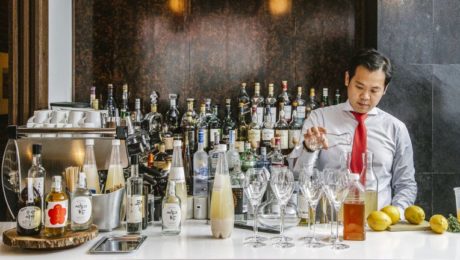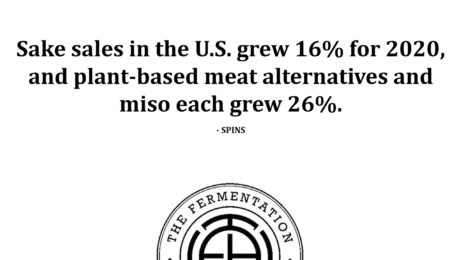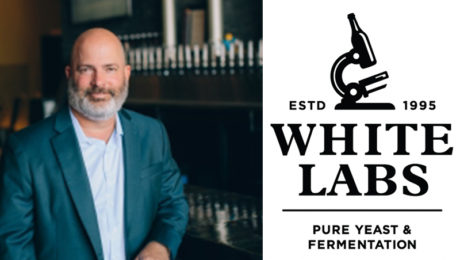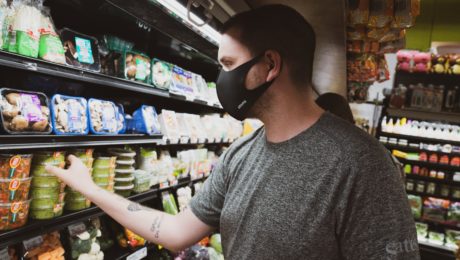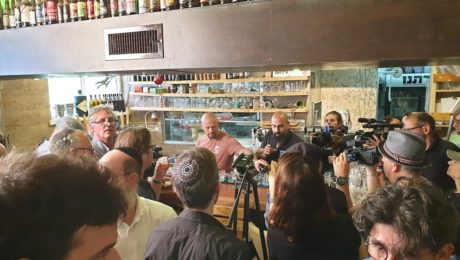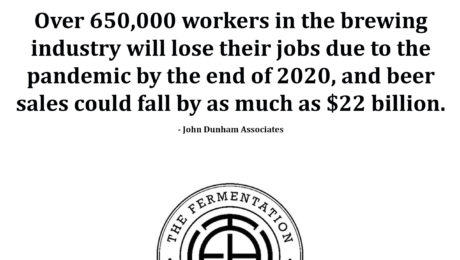Bringing Sool to America
Disappointed to find so little premium Korean sool in the U.S., Kyungmoon Kim @kimsomm_ms (who helped open Jungsik restaurant in New York City). Sool is Korea’s all-alcoholic beverages. In January 2020, Kim, a master sommelier, launched KMS Imports, the first importer of Korean sool featuring a small selection from nine producers. Kim wants to establish sool and soju, a Korean version of vodka, as a major spirit category and teach Americans about Korea’s brewing and distilling traditions.
“I believe soju can follow in the footsteps of mezcal: Fifteen years ago, nobody knew mezcal,” Kim says. “You could only find the cheapest grade bottles with worms inside. Now, regardless of cuisine, you can find mezcal behind the bar, and people appreciate nuances in flavor profiles and regional production. Soju has its own unique story, and once people understand it, they will want to learn more.”
Check out the SevenFiftyDaily article for a fascinating history into Korea’s ancient brewing traditions.
Read more (SevenFiftyDaily)
- Published in Food & Flavor
Sake, Miso & Plant-Based Meat Sales Grow
Sake sales in the U.S. grew 16% for 2020, and plant-based meat alternatives and miso each grew 26%. – SPINS
- Published in Business, Food & Flavor
Begging for Tax Relief for Alcohol
America’s small, craft beer, wine, cider and mead brewers are teaming up with 57 bipartisan senators to ask Congress to extend relief from excise taxes on alcoholic beverage products. These tax cuts, imposed by President Donald Trump in 2017, will expire at the new year.
The coronavirus pandemic has forced “dramatic declines in revenue” because of the closure of on-premise locations. The Beverage Marketing Corporation estimates up to 30% of craft breweries that existed in 2019 won’t make it through the pandemic. And stats by the Brewers Association show craft drinks make up more than 25% of the $116 billion U.S. beer market.
Read more (Food Dive)
- Published in Business
Food and Beverage Laws Passed in 2020
Every year, the nation’s 50 state legislatures pass dozens of new laws that have an impact on fermenters. For example, some states amended alcohol laws to allow drink sampling for craft wineries, while others repealed outdated cottage food laws to help small producers operate and more loosened take-out restrictions to help small restaurants survive the pandemic.
Indicative of this year’s focus on the pandemic, laws were introduced but never debated as lawmakers focused on more pressing issues surrounding the coronavirus. The most common new laws passed in 2020 revolved around helping businesses survive — states called special sessions to aid restaurants, stop price gouging of high-demand products and provide emergency grants to small businesses.
Read on for key food, beverage and food service laws passed this year, most taking effect in 2021.
California
AB82 — Prohibits an establishment with an alcohol license from employing an alcohol server without a valid alcohol server certification.
AB3139 — Establishments with alcoholic beverages licenses who had premises destroyed by fire or “any act of God or other force beyond the control of the licensee” can still carry on business at a location within 1,000 feet of the destroyed premise for up to 180 days.
Delaware
HB 237 — Eliminates old requirements that movie theaters selling alcohol must have video cameras in each theater, and that an employee must pass through each theater during a movie showing.
HB275 — Permits beer gardens to allow leashed dogs on licensed outdoor patios.
HB349 — Permits any restaurant, brewpub, tavern or taproom with a valid on-premise license to sell alcoholic beverages for take-out or drive through food service, so long as the cost for the alcohol did not exceed 40% of the establishment’s total sales transactions.
Hawaii
SR84 — Creates a Restaurant Reopening Task Force to help restaurants in Hawaii safely reopen that were closed during the COVID-19 pandemic.
SR94 — Urges restaurants to adopt recommended best practices and safety guidelines developed by the United States Food and Drug Administration and National Restaurant Association in response to the COVID-19 pandemic.
Idaho
HB343 — Amends existing law to require licensing to store and handle wine as a wine warehouse.
HB575 — Allows sampling of alcohol products at liquor stores, which was formerly forbidden under law.
SB1223 — Eliminates obsolete restrictions on food products, to match federal standards. It repeals requiring extra labels on some imported food products, and repeals using enriched flour in bread baking.
Illinois
HB2682 — Amends Liquor Control Act of 1934. Allows a cocktail or mixed drink placed in a sealed container at the retail location to be sold for off-premises consumption if specified requirements are met. Prohibits third-party delivery services from delivering cocktails or mixed drinks.
HB4623 — Amends Food Handling Regulation Enforcement Act, regulating that public health departments provide a certificate for cottage food operations, which must be displayed at all events where the licensee’s food is being sold.
Iowa
HB2238 — Amends code regarding food stands operated by a minor. Bans a municipality from enforcing a license permit or fee for a minor under the age of 18 to sell or distribute food at a food stand.
Kentucky
HB420 — Implements Food Safety Modernization Act, authorizing a department representative to enter a covered farm or farm eligible for inspection.
SB99 — Amends alcohol laws for state’s distillers, brewers and small wineries. Eliminates the sunset on local precinct elections to grant distilleries, and allows distillers to sell other distiller’s products.
Louisiana
HR17 — Allows third-party delivery services to deliver alcohol.
HB136 — Makes adulterating a food product by intentional contamination a crime.
SB455 — Increases the size of containers of high-alcoholic beverages.
SB508 — Gives restaurants protection from lawsuits involving COVID-19. The public will be unable to sue restaurants for COVID-19-related deaths or injuries, as long as the restaurant complies with state, federal and local regulations about the virus.
Maine
LD1167 — Encourages state institutions to serve Maine food and Maine food products, increasing the visibility of the state’s local food producers.
LD1884 — Amends current laws regarding businesses that hold dual liquor licenses, which authorized retailers to sell wine for consumption both on- and off-premise. Retailers with the dual license can now sell with just one employee at least 21 years of age present, and adds that wine can be sold for take-out if food is part of the transaction.
Maryland
HB1017 — Allows cottage food businesses to put their phone number and business ID on their food label, rather than their address as currently required by the Maryland Department of Health.
SB118 — Expands definition of “alcohol production” and “agricultural alcohol production.” The new definitions aim to give Maryland farmers and producers the ability to sell beer, wine and spirits to increase agritourism.
Massachusetts
SB2812 — Expands alcohol take-out and delivery options during COVID-19 pandemic. Allows restaurants to sell mixed drinks in sealed containers alongside other take-out and delivery food orders.
Michigan
HB5343 — Revises regulations on brewpubs and microbreweries, increasing the quantity of beer a microbrewer is permitted to deliver to a retailer during a year from 1,000 barrels to 2,000 barrels.
HB5345 — Amends the Michigan Liquor Control Code to delete the Michigan Liquor Control Commission (MLCC) $6.30 tax levied on each barrel of beer manufactured and sold in Michigan.
HB5354 — Amends the Michigan Liquor Control Code to delete the requirement that a brewpub cannot sell beer in Michigan unless it provides for each brand or type of beer sold a label that truthfully describes the content of each container.
SB711 — Establishes new limited production brewer license for microbreweries at cost of $1,000 for license.
HB5356 — Amends the Michigan Liquor Control Code to ban the required $13.50 cent-per-liter tax on all wine containing 16% or less of alcohol by volume sold in Michigan.
Minnesota
HB5 — Authorizes emergency, small-business grants and loan funding for businesses affected by COVID-19.
HB4599 — Extends period of mediation for Minnesota farmers suffering economic difficulties to keep their farm.
Mississippi
HB326 — Amends outdated code to increase the maximum annual gross sales for a cottage food operation (from $20,000 to $35,000) before the producer would need to pay food establishment permit fees. Authorizes a cottage food operation to advertise products over the internet.
New Jersey
AB2371 — Requires large generators of food waste (like restaurants and supermarkets) to recycle food garbage rather than send it to incinerators or landfills.
AB3865 — Limits return of food from retail food stores during a public emergency.
SB864 — Prohibits sale of single-use plastic carryout bags, single-use paper carryout bags and polystyrene foam food service products, and limits single-use plastic straws.
SB1591 — Allows alcoholic beverages to be consumed from open containers in the Atlantic City Tourism District.
SB2437 — Limits service fees charged to restaurants by third-party food takeout and delivery applications during COVID-19 pandemic.
New Mexico
SB3 — Enacts the Small Business Recovery Act of 2020, which provides loans for small businesses suffering during the coronavirus pandemic.
New York
SB8225 — Authorizes issuing a retail license for on-premise consumption of food and beverage within 200 feet of a church, synagogue or other place of worship.
AB8956 — Allows a licensed brewery or farm brewery to provide no more than four beer samples not exceeding four fluid ounces each.
SB1472 — Requires hospitals to offer plant-based food options to patients upon request.
SB7013 — Authorizes the manufacture and sale of ice cream or other frozen desserts made with liquor.
North Carolina
SB290 — The Alcoholic Beverage Control Regulatory Reform Bills, it allows distilleries the same serving privileges as wineries and craft breweries and reduces regulation on out-of-state sales.
Ohio
HB160 — Aid for the restaurant industry to recover from COVID-19 pandemic, the bill doubles the maximum number of Designated Outdoor Refreshment Areas (DORAs) that can be created in a municipality or township. Also allows Ohio’s small wineries to sell prepackaged food without regulation from the Ohio Department of Agriculture, creates bottle limits for micro-distilleries and permits license holders to sell alcoholic ice cream.
South Carolina
HB4963 — Amends state alcohol code, allows licensed retailers to give wine samples in excess of 16% alcohol, cordials or distilled spirits, as long as they don’t exceed a total of three liters a year.
SB993 — Amends state alcohol code to allow a permitted winery to be eligible for a special permit to sell wine at off-premise events. Also increases the amount of beer a brewery can sell to an individual per day for off-premise consumption.
South Dakota
HB1073 — Authorize special event alcohol licenses for full-service restaurant licensees.
HB1081 — Allows colleges to teach brewing beer and wine classes on South Dakota campuses to students age 21 or older. Brewing must be held off campus as the education institution is not deemed a licensed manufacturer. Any distilled spirits, malt beverage, or wine produced under this section may only be consumed for classroom instruction or research and may not be donated or sold.
Tennessee
SB2423 — Allows alcohol sales at the Memphis Zoo.
SB1123 — Encourages farmers who produce raw milk to complete a safe milk-handling course.
Utah
HB134 — Legalizes the sale of raw butter and raw cream in Utah;
HB232 — An agri-tourism bill that allows farms and ranches to host events that include food that would not need to be prepared in a commercial kitchen. Farmers must apply for a food establishment permit to use their private home kitchen.
HB399 — Changes to the Alcohol Beverage Control Act, prohibits advertising that promotes the intoxicating effects of alcohol or emphasizes the high alcohol content of an alcoholic product.
HB5010 — The COVID-19 Cultural Assistance Grant Program, which appropriates $62 million for struggling arts, cultural and recreational organizations and businesses across the state.
HB6006 — In response to the coronavirus pandemic, the bill amends the Alcohol Beverage Control Act, delaying the expiration date of the retail licenses set to expire in 2020 for places selling alcohol. Also permits alcoholic beverage licensees at international airports to change locations if needed.
Vermont
SB351 — A coronavirus relief bill which authorizes $36 million for agriculture and forestry sectors.
Washington
HB2217 — An update to Cottage Food Law eliminates the requirement that a home address must be put on a food label.
HB2412 — Increases amount of additional retail licenses for a domestic brewery or microbrewery from two to four, and directs health department to adopt rules allowing brewery owners to allow dogs on brewery premise
SB5006 — Allows sale of wine by microbrewery license holders.
SB5323 — A bill eliminating single-use, plastic carry-out bags
SB5549 — Modernizing resident distillery marketing and sales restrictions. Allows distilleries to sell products off-premise, similar to breweries and wineries.
SB6091 — Continues work on the Washington Food Policy Forum, including support for small farms and increasing the availability of food grown in the state.
West Virginia
HB4388 — Removes outdated restrictions on alcohol advertising, limiting the Alcohol Beverage Control Commissioner’s authority to restrict advertising in certain advertising mediums, such as at sporting events and highway billboards.
HB4524 — Making the entire state “wet,” permitting the off-premises sale of alcoholic liquors in every county and municipality in the state.
HB4560 — Permits licensed wine specialty shops to sell wine with a gift basket by telephonic, electronic, mobile or web-based wine ordering. Establishes requirements for lawful delivery.
HB 4697 — Removes restriction that a mini-distillery use raw agricultural products originating on the same premises
HB4882 — Allows unlicensed wineries not currently licensed or located in West Virginia to provide limited sampling and temporary, limited sales for off-premise consumption at fairs, festivals and one-day nonprofit events “in hopes that such wineries would eventually obtain a permanent winery or farm winery license in West Virginia.”
Wisconsin
HB1038 — Bans customers from returning food items during a health pandemic or emergency, dissuading people from stocking up on too many supplies.
SB83 — Increases sales volume of alcohol by retail stores from four liters per transaction to any quantity.
SB170 — Allows minors to operate temporary food stands without a permit or license.
Wyoming
HB82 — Authorizes a microbrewery to operate at more than one location. The local licensing authority may require the payment of an additional permit fee not to exceed $100.00.
HB84 — Authorizes the sale of certain homemade food items that do not require time or temperature control. These include but are not limited to:
but is not limited to, jams, uncut fruits and vegetables, pickled vegetables, hard candies, fudge, nut mixes, granola, dry soup mixes excluding meat based soup mixes, coffee beans, popcorn and baked goods that do not include dairy or meat frosting or filling or other potentially hazardous frosting or filling;
“non-potentially hazardous” (no dairy, quiches, pizzas, frozen doughs, foods that require refrigeration and cooked meat, cooked vegetables and cooked beans). Allows someone other than the producer to sell the food, as long as food is not sold in a retail location or grocery store where similar food items are displayed or sold. Food must be labeled with “food was made in a home kitchen, is not regulated or inspected and may contain allergens.”
HB158 — Allows microbreweries to make malt beverages at multiple locations rather than one as deemed in current law.
Q&A with Chris White, White Labs
As a biochemistry grad student with a penchant for homebrewing, Chris White never thought his growing collection of yeast strains would amount to anything outside a hobby. But when White graduated with his PhD and was offered a lucrative job in the biotech field, one caveat kept him from accepting the offer — there were no side jobs allowed.
“I never had some big plan to start a company. But I liked all the fermentation stuff I was doing and didn’t want to let go of my yeasts,” says White, CEO and founder of White Labs. “I said no to the job, and from there White Labs kept going and going and getting bigger and bigger.”
Today, White Labs is a powerhouse in the fermentation industry. They provide professional breweries with liquid yeast, nutrient blends, educational classes, analytic testing and private consulting.
White Labs is celebrating a landmark 25th anniversary this year, despite a global pandemic that has shuttered breweries. They have released their own line of beer, created a new nutrient blend for hard seltzer brands, began a YouTube series and launched free how-to education classes for homebrewers. White Labs will host a year in review webcast on Dec. 9.
“We’ve had a lot of success and we’ve made a lot of mistakes, and we’ve tried to learn from those mistakes. But we’re a team. And we really got lucky that we hired people interested in fermentation that helped build this company,” White says. “Everyone really pulled together during COVID and did whatever was needed. It’s been a great experience because we had solutions and we had teamwork. And I think it’s taken 25 years to get to that team, that tribe.”
A yeast guru, White is a co-author of the book “Yeast: The Practical Guide to Beer Fermentation.” Below, check out our Q&A with White.
The Fermentation Association: You studied biochemistry at University of California, Davis, then got your PhD in biochemistry at University of California, San Diego. What made you decide to dive into yeasts?
CW: I was always interested in science since high school chemistry, and then in college was interested in how cells work, how DNA worked. It drove me to where I am today, really. Most people I went to school with at UC Davis, they were studying biochemistry to be a physician. But that’s not what I wanted to do, I was more interested in biotech and grad school.
Meanwhile, I was homebrewing. It was a great combination of things that happened. The science and homebrewing is what led me to put that together and make yeast for homebrewing, then yeast for craft brewing.
TFA: Is that what led you to start White Labs?
CW: It really was. I like beer. I was fascinated with how it could be made. It’s pretty simple to make beer — simple, but not easy. It’s difficult to make a great beer. But it’s fairly simple since it’s only four ingredients if you include the water. That’s what’s great about a lot of fermentation, the raw materials are all around you. They’re simple. Making it taste good is the hard part, that’s the art of it. I liked beer, I really got into homebrewing, then the people I was making homebrewed beer with started a store in San Diego, Home Brew Mart, in 1992. We became friends and that’s who I was homebrewing with every weekend. Then my friend from the store said “Hey, we need yeast,” and I started a little company on the side to make yeast. It wasn’t like I had some big plan to start a company, I thought I’d just make a little each week. And then other people asked and other people asked. By the time I got closer to finishing grade school, I just didn’t want to stop doing the yeast for brewing.
TFA: Now there are over 1,000 strains of yeast in the White Labs yeast bank. Tell me about it.
CW: We have a yeast bank that I spent a lot of time building in the beginning, more for my own brews, but obviously later on, it became more and more. The foundation of our company is our yeast strains and the way we store them. We’re collecting strains all the time. But what I did in the beginning was collect different strains from travel, from different yeast banks. We created our own private yeast bank at White Labs, but there are yeast banks around the world. Especially in Europe where brewing really began in an industrial way and where yeast was discovered and started to get collected. There’s a great yeast bank in Denmark, Germany, the UK. I spent a lot of time acquiring strains from those.
You get to know the yeast in a different way, the strains, what they do. Performance, conditions. But for beer especially, it’s really how they taste, which is so important. We only make those flavors through fermentation. We still continue to acquire strains. People send them to us, we bank private strains for companies, sometimes they buy them in a liquid form we make for them, sometimes we just store it for them. But usually, they’re banking it for us to make something with it.
TFA: Besides yeast, White Labs offer testing services as well.
CW: White Labs Analytical Lab is really separate in the fact that a lot of people that work in that lab don’t really have anything to do with the yeast. It’s just testing samples. They’re usually fermented beverages. Yes, there’s beer there, but that’s just a part of White Labs Analytical Lab. There’s the spirits that come for testing, kombucha, cider, mead, any kind of commercial business making a fermented beverage that needs some kind of testing. Sometimes it’s regulatory for export. Sometimes it’s just for their own data, like actual alcohol by volume instead of calculated, sometimes it’s microbiology or tracking down a problem or contamination. It’s all confidential, like everything at White Labs. But we get to work with a lot of cool companies, a lot of them may not get yeast from us, that’s really not a requirement. The yeast and testing run separate.
TFA: Have you seen kombucha brewing grow?
CW: Oh yeah. Originally, that’s how we got into analytical testing because people were asking for alcohol lab evaluations, which is so important in kombucha. We all know what happened there (Whole Foods pulled all kombucha bottles off shelves in 2010 after several brands tested at higher alcohol beverage levels then what was printed on the bottles). And it happened because it’s a biological process. You put that thing in a bottle and it’s going to keep fermenting. People had to really try to figure out what to do with that. So a lot of alcohol testing, and a lot of that is regulatory in kombucha.
But then we started making SCOBYs because a couple of our staff got really into it. Just like I started making yeast in my own home brewing, they started making SCOBY in White Labs for their own kombucha making. So we said “Let’s sell it.” And now we make a bunch of it.
TFA: That’s forward-thinking, expanding your offerings to all fermented drink products.
CW: Yeah and the different facilities allow us to do different things. We grow all the SCOBYs in North Carolina because it was a new facility at the time and had the space, San Diego is full.
TFA: White Labs released their own canned beer in July. Tell me about it.
CW: A lot of the things that came out of this year really were not new ideas, like canning. Someone gave a presentation at White Labs during one of our internal innovation summits that’s open to anyone in the staff about canning beer. But during this time of COVID, when we’re not focusing on growth, we were able to work on a lot of those projects and really build a better company. Once we gave up the idea that revenue is not going to go up right now, we worked on other things. And it’s been great. A lot of cool things have been coming out of our teamwork this year, and one of those was canning.
So we said let’s do that because we’re not selling beer in our tap room — we’ve got a tap room in San Diego for White Labs Brewing Company and a kitchen and tap in Asheville, it’s more of a full restaurant. We weren’t selling a lot of beer and we have a lot of beer, so why not can it? We have done three different beers now in cans. The IPA, a hazy IPA and the pilsner. And we’re going to do another lager and IPA next month. It’s been fun for the brewers to be able to brew it. I think it’s been a nice boost for everyone in the company, not even money wise, just to have another milestone: we put our beers in cans. It’s a nice billboard for the brewery. And they get to have fun with graphics, and how to tell our story, and really share what we’re doing in the tap rooms.
People are amazed that it’s the same beer, same exact batch but put into smaller fermenters and pitched with two different yeast strains. They say “Wow, you created different flavor beers? They taste different?” Yeah, because that’s fermentation. Fermentation makes these flavors and when people taste that it’s the same exact beer made with two different yeast strains, they get it in 30 seconds. “Oh that’s what a yeast does?” But you have to come to our tap room to experience that. And obviously during these times, you can’t come to the tap room. But canning is a way to share that with people outside the tap rooms.
TFA: Who buys more yeast from White Labs — commercial producers or homebrewers?
CW: Commercial because of volume. But we’re available for everything in homebrew. We try to mirror every test, every yeast strain, and make those available for home brewing because that’s our roots and I think it’s important. There’s been growth in home brewing during COVID. People at home with a hobby are buying yeast. That’s kind of nice, I like to see that.
TFA: Craft brewing has been hit so hard by pandemic. What have you seen your clients doing to survive?
CW: They’re getting creative. People had to figure out the to-go thing, first of all. That maybe involved buying software or creating a new website. Each company I talk to, regardless of what industry, they had to do something technology wise. Very few could close the bar door and were all set up to sell everything through the warehouse.
I think customers were also really good about supporting local businesses, wanting to help them. There’s been a lot of to-go. But it still doesn’t compare to all the beer they could sell, all the stuff that gets sold through bars. Even if one little meadery sells more to go, it doesn’t replicate all the tap room business that just disappears.
TFA: What do you think is the future of the fermented drink industry?
CW: It’s up to them. We pay attention so we can be there to help. But really these things come from creative people. New things have to come out. That keeps the industry growing. And I don’t know what those new things are, but we try and pay attention.
I think transparency and honesty is a hallmark of fermentation industries — whether craft breweries or wineries — and I hope that stays. That’s been a big part of the trust with consumers, and the fact that you can do these things at home too, so you know how it’s done. And with new techniques or things that get introduced, I think the industry needs to keep the transparency part of the business. Because fermentation being such an old, old method — a lot of people would like to replace fermentation with something else. They say “Let’s just mix these things together rather than do that weird fermentation.” But weird fermentation is what makes it so special.
- Published in Business, Food & Flavor
Pandemic Prompts Premium Purchases
More Americans are purchasing premium foods during the pandemic. Growth is fueled by Millennial consumers looking to have an “experience” from home, eating fancy food from their kitchen table during the pandemic rather than going out. Many fermented products are considered premium. According to market research firm IRi, five of the top 15 food categories with a “premiumization” effect are fermented products: spirits, beer/ale/cider, wine, coffee and yogurt.
Read more (IRI Worldwide)
- Published in Business, Food & Flavor
Digging Up Ancient Yeasts
Would you drink a beer made from 3,000-year-old yeast?
Craft’s new frontier is ancient beer. Archaeologists and scientists are partnering with brewers to use the yeast from archaeological dig sites to make unique craft beer. An article in anthropology magazine Sapiens details Biratenu bar in Jerusalem taking a sip of beer made with yeast from a 3,000-year-old archaeological site. The article reads: “This feat demonstrated that the microorganisms driving fermentation had managed to reproduce and survive for thousands of years. It also settled any debate over the vessels’ purpose — confirming that the jugs with strainers once stored beer for the Philistines some three millennia ago.” Though wine is the historically recorded drink of choice for historians, “beer is telling us about everything from gender roles to agriculture,” says archaeologist Marie Hopwood.
Read more (Sapiens)
- Published in Food & Flavor
Cider 2020: The State of the Art of Cidermaking
When Kirsten and Christopher Shockey moved onto their southern Oregon farmland 22 years ago, they envisioned starting a cidery. The century-old apple trees on the property produced perfect cider apples with an optimal mix of tannins and sugar. Cider ignited their love of fermentation.
“Really our fermentation journey started here on this place,” says Kirsten, author and fermentation educator (as well as a TFA Advisory Board member). She and her husband spoke at a recent TFA webinar Cider 2020: The State of the Art of Cidermaking, and talked about the state of the industry today.
This year has been full of surprises for cider producers. Sales had begun to flatten in 2019, as drinks like hard seltzer pulled from their market share. But, as the COVID-19 pandemic took root this spring, consumers started buying large amounts of cider, hoarding it along with toilet paper and hand sanitizer. Regional brands in particular have netted strong growth, some seeing gains of up to 30%. But this short-term growth spurt has created an odd, contradictory situation in the industry.
“We’ve got this real interesting dichotomy,” Christopher says. “Cider sales are up over 12%, but when you talk to orchards, farmers, cideries, especially small ones, you get a different picture. A lot of our friends in the cideries are cutting back their production, they’re not buying as many apples. Cideries are cutting back their apple orders.” The Shockeys theorize that these recent sales have been filled from existing inventories, while producers remain cautious about sales projections for 2021 and beyond.
What does this all mean for you as a cider producer, as well as for the future of the industry? The Shockeys shared their recommendations, observations and predictions.
- Pick a niche. What is your cider brand’s defining characteristic? Is it your background story? Where do you source your apples? Differentiate, Christopher advises.
- Focus on target demographic. Different age groups purchase alcohol differently. Millenials and Gen Z, for example, avoid wine. How can your cider cater to your target age group?
- Respond to consumer movement. People are leaving the city for the country, as more and more work remotely and are no longer tethered to an urban office location. This migration will affect distribution and sales patterns as consumers relocate around the country.
- Find unique marketing opportunities. Though many tap rooms are currently closed, cider clubs are finding success providing the latest flavors to customers 4-6 times a year. These are guaranteed sales, and help cideries sell out of kegs rather than bottles.
- Embrace unusual flavors. The Shockeys detailed the differences between traditional cider (apples only) and modern cider (using other fruits and botanicals). Christopher’s favorite is a persimmon cider, while Kirsten loves one made with manzanita yeast that produces a Christmas spice flavor. In 2020, pineapple-flavored ciders have sold particularly well.
- Understand there will be less business spending. Restaurants, hotels and conferences will not be reliable sources of income for cider makers until the coronavirus pandemic is over. Even then, it may take a while for these outlets to recover.
- Explore home delivery. Regional brands implementing home delivery are seeing big sales.
- Fight for fridge space. People are not getting bigger refrigerators and they’re not drinking on-premise during the pandemic, so cider makers must figure out how to compete for their share of consumer purchases.
Attending Cider 2020 was a range of individuals, from master cidermarkers to DIY home brewers. The Shockeys shared tips for hobbyists as well as professionals. They also offered further advice through a chapter that didn’t make it into their recently-published The Big Book of Cidermaking but is available here: www.storey.com/cider-business.
For anyone interested in purchasing The Big Book of Cidermaking, or in any of the Shockeys’ four titles on fermentation – a fifth, on vinegar, will be released next year – please visit the Shockey’s Amazon store.
- Published in Food & Flavor
The Science Behind Indigenous Wine
Australian wine scientists have published results of their research into the traditional practices Australian Aboriginal people used to make fermented beverages. Published in Scientific Reports, scientists from the University of Adelaide and the Australian Wine Research Institute (AWRI) “have discovered the complex microbial communities associated with the natural fermentation of sap from the iconic Tasmanian cider gum, Eucalyptus gunni.” The sweet sap from the trees produce a mildly alcoholic beverage when given time to spontaneously ferment.
Research leader Professor Vladimir Jiranek, Professor of Oenology with the University’s School of Agriculture, Food and Wine, says: “The wider community is not typically aware of these historic traditions. This work shines a light on these practices and the cultural significance of these unique fermentations. It also allows us to identify new strains, or species, of yeast and bacteria from the fermentations that are unique to Australia. Further work will characterize single microorganisms that have been isolated and grown from the cider gum. We are particularly interested in their fermentative abilities, their potential flavor impacts, how they’ve adapted to the cider gum environment and the possible symbiotic relationship they have with the trees. We look forward to continuing our work with relevant Aboriginal communities in order to understand these and other processes, and help revive lost practices or perhaps develop new ones from these.” (Phys.org) https://bit.ly/35eDgnr
- Published in Science
Brewing Industry Takes Big Hit in 2020
Over 650,000 workers in the brewing industry will lose their jobs due to the pandemic by the end of 2020, and beer sales could fall as much as $22 billion. – John Dunham Associates
- Published in Business

